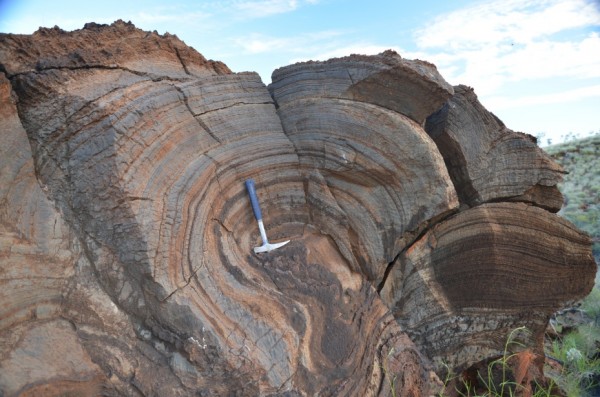Earth's Ancient Atmosphere Was So Thin, It Weighed Less Than Half of it Today
| Ana Verayo | | May 10, 2016 12:08 AM EDT |
(Photo : Roger Buick/University of Washington) The layers on this 2.7 billion-year-old rock, a stromatolite from Western Australia, show evidence of single-celled, photosynthetic life on the shore of a large lake. The new result suggests that this microbial life thrived despite a thin atmosphere
Some ancient air bubbles that were discovered to be trapped in 2.7 billion year old lava flows in Western Australia's Pilbara, now provide possible evidence about how Earth's atmosphere would have weighed less than half of its volume today, suggesting it was thinner and more tenuous than first thought.
Like Us on Facebook
This also means that Earth could have stayed almost free from any ice during that time even if the sun was much cooler before as opposed to today.
Researchers from the University of Western Australia examined and analyzed air bubbles found inside lava flows located in the Beasley River, in the aboriginal Pilbara region of Western Australia. These lava flows possess distinct features such as "toes", with cracked, glassy surfaces, suggesting that massive ribbons of this molten hot rock have crawled and dived into a beach.
According to author of the study, astrobiologist David Catling from the University of Washington, the sun was apparently about less than 20 percent luminous some 2.7 billion years ago, which means that Earth's atmosphere would have been covered in ice crystals today if the sun still shined the way it did billions of years ago. However, there are still similar conditions on Earth that still remain.
Catling says that the climate system back then also had rainfall and rivers and it is also possible that polar ice caps existed, however it is still warm enough for the planet to be not covered entirely in ice.
Today, theories about warmer than usual climate conditions involve our atmosphere becoming thicker and more dense through time, insulating the planet.
However, this new evidence of air bubbles preserved in rock that would have originally been under sea level reveals a totally different idea about the planet's atmospheric pressure especially during the Archean period, spanning from the formation of the crust 4 billion years ago to 2.5 billion years back.
In this new study, researchers compared the sizes of the air bubbles trapped on the surface of the lava flows which have been only affected by air pressure, and air bubbles trapped at the base of the molten rock, that have been affected by both air pressure and the lava itself, to determine the precise air pressure of the planet when this lava flow occurred.
Catling says that the results revealed that the atmosphere is basically a lot thinner during that time, weighing less than half of how it is today.
This would also mean that Earth some 2.7 billion years ago was home to only single celled organisms, as sunlight was one fifth weaker, and most importantly, the planet's atmosphere has no oxygen yet. A lighter atmosphere means weaker winds, different climate patterns including boiling point of liquids.
This new study is published in the journal, Nature Geoscience.
Tagsair pressure, early earth atmosphere, ancient lava bubbles, Western Australia, earth ancient atmosphere thin
©2015 Chinatopix All rights reserved. Do not reproduce without permission
EDITOR'S PICKS
-

Did the Trump administration just announce plans for a trade war with ‘hostile’ China and Russia?
-

US Senate passes Taiwan travel bill slammed by China
-

As Yan Sihong’s family grieves, here are other Chinese students who went missing abroad. Some have never been found
-

Beijing blasts Western critics who ‘smear China’ with the term sharp power
-

China Envoy Seeks to Defuse Tensions With U.S. as a Trade War Brews
-

Singapore's Deputy PM Provides Bitcoin Vote of Confidence Amid China's Blanket Bans
-

China warns investors over risks in overseas virtual currency trading
-

Chinese government most trustworthy: survey
-

Kashima Antlers On Course For Back-To-Back Titles
MOST POPULAR
LATEST NEWS
Zhou Yongkang: China's Former Security Chief Sentenced to Life in Prison

China's former Chief of the Ministry of Public Security, Zhou Yongkang, has been given a life sentence after he was found guilty of abusing his office, bribery and deliberately ... Full Article
TRENDING STORY

China Pork Prices Expected to Stabilize As The Supplies Recover

Elephone P9000 Smartphone is now on Sale on Amazon India

There's a Big Chance Cliffhangers Won't Still Be Resolved When Grey's Anatomy Season 13 Returns

Supreme Court Ruled on Samsung vs Apple Dispute for Patent Infringement

Microsoft Surface Pro 5 Rumors and Release Date: What is the Latest?










